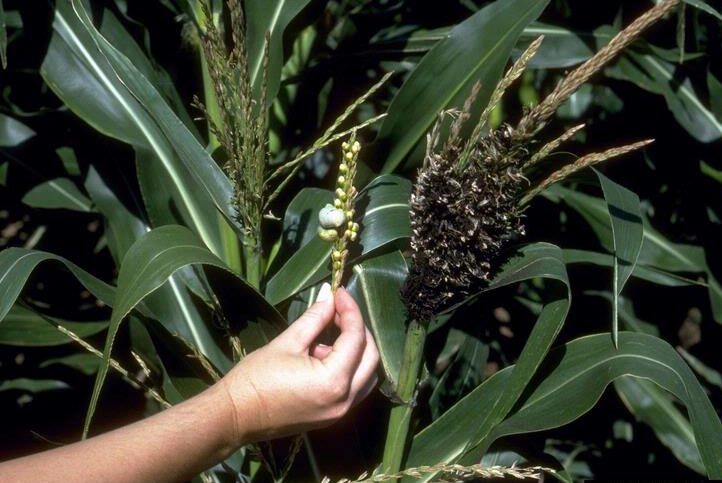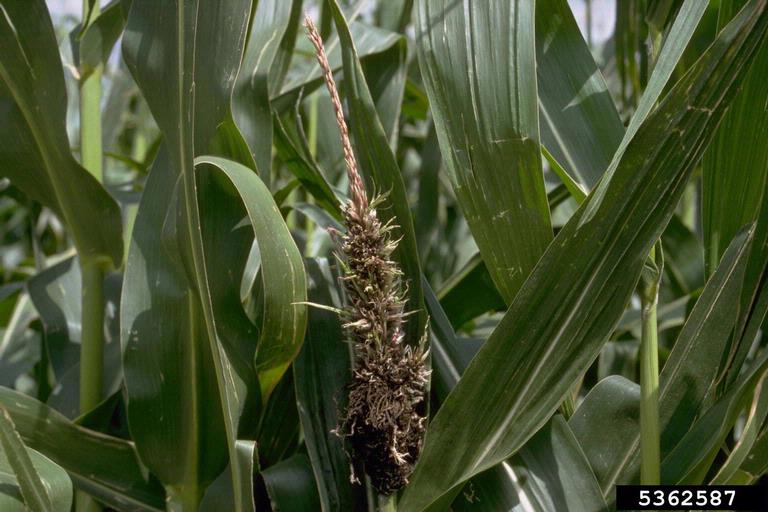Head smut, caused by the fungus Sporisorium holci-sorghi (also known as S. reilianum and Sphacelotheca reiliana), is a plant disease that affects corn and sorghum crops. While it is not as widespread and damaging in the Midwest as kernel smuts, it still poses a significant threat to agricultural productivity in the region.
Head smut is more commonly observed on sorghums compared to corn. Moreover, distinct physiologic races of the fungus exist on both corn and sorghum plants, indicating the complexity of this pathogen and its adaptability to different host species.
An important factor contributing to the severity of head smut outbreaks is the intensive cultivation of susceptible hybrid crops. As farmers increasingly grow these hybrids, the disease finds favorable conditions to spread and establish itself more aggressively in the fields.
Apart from the characteristic head smut symptoms, infected plants also suffer from weakened root systems. This predisposes them to other soil-borne diseases, leading to more severe stalk and root rots compared to healthy, smut-free plants.
Quick Guide to Head Smut of Sorghum:
Symptoms of Head Smut of Sorghum:

- The entire ear head is either completely or partially replaced by a large whitish gall.
- The spores are blown away, exposing the dark filaments.
- The entire head is replaced by large sori. The sorus is covered by a whitish-grey membrane of fungal tissue, which ruptures before the head emerges from the boot leaf to expose a mass of brown smut spores. The spores are embedded in long, thin, dark-colored filaments, which are the vascular bundles of the infected head.
- Individual grains of sorghum are replaced by smut sori covered by a persistent membrane (peridium).
- The size of the sori varies, ranging from those small enough to be covered by the glumes (tiny leaves) to those larger than 1 cm long.
- Most sori are conical or oval in shape, resembling an elongated sorghum seed. They can be whitish, grey, or brown and may display grey and brown stripes.
- The typical dimensions of the sori are 0.4-1.3 cm long and 0.2-0.4 cm wide.
- Smut sori can be localized at the top, bottom, or sides of the infected head.
- Unusual symptoms may sometimes be observed, such as individual spikelets or inflorescences missing in smutted panicles. In such cases, the panicle is reduced to a few twisted, distorted branches covered with large, superficial smut sori.
Also Read: Grassy Stunt Disease of Rice: Symptoms, Disease Cycle, and Management
Management of Head Smut of Sorghum:
Preventing Method:
Izumonas-Best Fungicide
Contents: Pseudomonas Fluorescens
IZUMONAS is a biological product consisting of plant growth-promoting rhizobacteria (PGPR), which are naturally occurring bacteria found widely in nature. This unique product is designed to enhance plant defence mechanisms and promote healthy growth. IZUMONAS can be used on all types of crops without leaving any residue on the plants.
Izumil-Best Fungicide
Contents:
- Extract of Streptomyces griseus: 30%
- Extract of Streptomyces violaceus: 40%
- Dissolving agents: 30%
IZUMIL is a remarkable biotech research product that has been developed to activate the natural defence mechanism of plants. By using IZUMIL, plants can better protect themselves against fungal pathogens, improve their physiological functions, and develop resistance against various harmful microorganisms. Similar to IZUMONAS, IZUMIL can be safely used on all crops without leaving any residue.
Modes of Use:
- Seed Treatment: Mix 5-10 ml of IZUMONAS and IZUMIL per kilogram of seeds in an adequate amount of water. Submerge the seeds in this solution and allow them to dry in a shaded area before sowing.
- Seedling Treatment: Combine 100 ml of IZUMONAS and IZUMIL per 20 litres of water. Dip the roots of the seedlings in this solution for approximately 30 minutes prior to transplanting.
- Soil Application: Mix 500 ml of IZUMONAS and IZUMIL with 30 kilograms of farmyard manure (FYM) or soil. Apply this mixture to one acre of land before ploughing or irrigation.
- Foliar Application: Dilute 2-3 ml of IZUMONAS and IZUMIL each in 1 litre of water. Use this solution to spray the entire foliage of the plants, ensuring complete coverage on both sides of the leaves. It is advisable to shake the bottle before use. For best results, spray early in the morning or evening. If a power sprayer is used, double the recommended dosage.
Also Read: Bacterial Leaf Streak of Rice: Symptoms, Disease Cycle, Management
Cultural Method:
- Soak the seeds in water for four hours and then dry in the sun. Such methods keep intact seed viability while destroying spores.
- S. sorghi spores can live in the soil for long periods of time so rotation of crops every four years is another method of control.
- The burning of sorghum plants before the release of teliospores may be effective, although this does reduce crop yield.
- Planting the sorghum kernels in 15.5-32 degree Celsius soil further serves as a preventative measure that limits S. sorghi germination.

